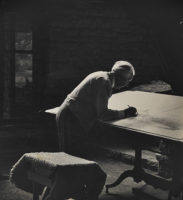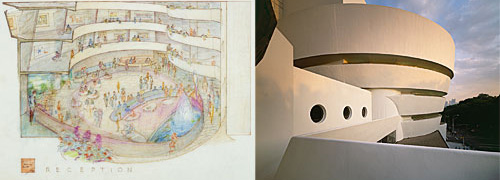Frank Lloyd Wright Exhibition Opens at the Guggenheim

Frank Lloyd Wright Exhibition Opens at the Guggenheim
Frank Lloyd Wright during construction of the Solomon R. Guggenheim Museum, New York, ca. 1959.
Photo by William Short © The Solomon R. Guggenheim Foundation

Frank Lloyd Wright Exhibition Opens at the Guggenheim
Crowds lined up at the opening of the Solomon R. Guggenheim Museum, New York, October 21, 1959.
Photo by Robert E. Mates © The Solomon R. Guggenheim Foundation

Frank Lloyd Wright Exhibition Opens at the Guggenheim
Solomon R. Guggenheim Museum; New York; 1943–59.
Image © The Frank Lloyd Wright Foundation

Frank Lloyd Wright Exhibition Opens at the Guggenheim
Solomon R. Guggenheim Museum; New York; 1943–59.
Image © The Frank Lloyd Wright Foundation; Photo © The Solomon R. Guggenheim Foundation

Frank Lloyd Wright Exhibition Opens at the Guggenheim
Larkin Company Administration Building (demolished); Buffalo, New York; 1902–06.
Images © The Frank Lloyd Wright Foundation

Frank Lloyd Wright Exhibition Opens at the Guggenheim
Gordon Strong Automobile Objective and Planetarium (project); Sugarloaf Mountain, Maryland; 1924–25.
Image © The Frank Lloyd Wright Foundation

Frank Lloyd Wright Exhibition Opens at the Guggenheim
Steel Cathedral (project); New York; 1926.
Image © The Frank Lloyd Wright Foundation

Frank Lloyd Wright Exhibition Opens at the Guggenheim
Steel Cathedral (project); New York; 1926.
Image © The Frank Lloyd Wright Foundation

Frank Lloyd Wright Exhibition Opens at the Guggenheim
Unity Temple; Oak Park, Illinois; 1905–08.
Image © The Frank Lloyd Wright Foundation

Frank Lloyd Wright Exhibition Opens at the Guggenheim
Herbert Jacobs House #1; Madison, Wisconsin; 1936–37.
Photo by David Heald © The Solomon R. Guggenheim Foundation; Photo by Larry Cuneo © The Frank Lloyd Wright Foundation

Frank Lloyd Wright Exhibition Opens at the Guggenheim
Imperial Hotel, Scheme #2 (demolished); Tokyo; 1913–22.
Image © The Frank Lloyd Wright Foundation

Frank Lloyd Wright Exhibition Opens at the Guggenheim
Imperial Hotel, Scheme #2 (demolished); Tokyo; 1913–22.
Photograph © Hulton Archive/Stringer/Getty Images; courtesy The Solomon R. Guggenheim Foundation












This year marks the 50th anniversary of the completion of Frank Lloyd Wright’s Solomon R. Guggenheim Museum in New York—a landmark structure often condemned by artists but extolled by architects. It also marks the 50th anniversary of the death of Wright, who had unfortunately missed the opening on October 21, 1959. He passed away six months prior at the age of 91.
Frank Lloyd Wright during construction of the Solomon R. Guggenheim Museum, New York, ca. 1959.
To commemorate these events, the Guggenheim Foundation joined with the Arizona-based Frank Lloyd Wright Foundation to bring Wright’s own artistic production to public attention in the recently restored building on Fifth Avenue. The exhibition, Frank Lloyd Wright: From Within Outward, features over 200 original drawings and a number of historic models, supplemented by newly commissioned models and digital animations. It opens this Friday and runs through August.
It’s the first time the Guggenheim has mounted a comprehensive exhibition of Wright’s work in this building. (Three years before groundbreaking, in 1953, it presented Sixty Years of Living Architecture in a temporary pavilion on the site). It is only fitting that the institution should celebrate the golden anniversary of its pioneering building with a show devoted to Wright: He is inarguably the United States’ best-known architect, and the Guggenheim is among his best-known projects. And the question soon to be answered is how well the display of Wright’s work survives in this controversial museum of his design.
Over the years, the Guggenheim’s installations have risen or succumbed to the complexity of the parti. The organically innovative architecture has been subject to vitriolic attacks by disgruntled artists, who have disagreed with the novel concept of combining viewing and circulation on one spiraling ramp. When the Guggenheim opened, a number of artists were already in a lather that paintings would be mounted on the sloping back walls of the narrow vertiginous ramp. James Johnson Sweeney, the museum director who battled with Wright over his scheme, was blasted for his solution in which he mounted the paintings on projecting rods: The works, according to a contemporaneous review in ARTnews, looked like “marshmallows stuck to the ends of twigs.”
Friedrich Kiesler, the architect-artist who dreamed up the biomorphic Endless House during this time, proposed, according to the art magazine, “they remove all the paintings in the Guggenheim Museum and commission a sculptor to make a gigantic statue of Wright that would fill the whole interior: his cenotaph, with crowds strolling down past majestic nostrils and shoelaces.” Moreover, Kiesler, writing in his journal, said about the Gugg: “I have compassion for those modern artists who must smuggle their art in like contraband. There, they are the intruders.”
Now we have Wright’s own “contraband” with an exhibition of fragile and difficult-to-see-drawings—some of which have never been viewed by the public. The exhibition’s curatorial team had to come up with its own solution to address the ramp’s notorious display challenge.
The assemblage of curators includes Thomas Krens, curator and senior advisor of international affairs for the Guggenheim Foundation; David van der Leer, assistant curator of architecture and design; and Maria Nicanor, curatorial assistant—all from the museum, who teamed up with Bruce Brooks Pfeiffer, director of the Frank Lloyd Wright Archives; Margo Stipe, curator and registrar of collections for the archive; Oskar Muñoz, assistant director of the archives; and finally Mina Marefat, an architect and Wright scholar who was curatorial consultant for Wright’s Baghdad project of 1957-1958 in the exhibition.
For installation help the group turned to Wendy Evans Joseph, FAIA , the New York architect who sympathetically restored and converted Wright’s Price Tower of 1956 in Bartlesville, Oklahoma, into a hotel and gallery in 2003. Joseph knew the drawings were kept in transparent film for protection. To avoid problems of the film’s reflectivity and its tendency to buckle, she designed large wood and glass vitrines that slant on an angle like drafting tables, and placed these units on welded steel frame bases. They are arranged on the ramps at odd angles and pulled out from the wall, so that their quiet contents stand distinctly apart from the large dominating container. Models and continuous-loop videos of historic photos supplement the displays, but are kept small in scale to allow the purity and calm of the lush, stunning drawings—whether graphite and colored pencil on paper, (e.g., Steel Cathedral of 1926), or ink and watercolor on art paper (e.g., Unity Temple, in Oak Park, Ill. , 1905-1908) to be viewed without distraction.
The exhibition continues into the annex designed in 1992 by Gwathmey Siegel & Associates, where installations have breathing space, including a three-dimensional exploded model of the Herbert Jacobs House Number 1 (1936-37) created by Situ Studio. A smaller show in the museum’s Sackler Center for Arts Education features architecture designed by students at the Frank Lloyd Wright School of Architecture in Arizona and Wisconsin, and was curated by the indefatigable van der Leer, with Joseph consulting on the installation.
So what would Frank Lloyd Wright make of this exhibition? (One does wonder how he would have installed it). Richard Armstrong, director of the Guggenheim, rightly points out that, criticism or not, Wright reinvented the art museum. The one thing lacking in this show, however, might be Kiesler’s contribution: a giant statue of Wright looming up through the atrium.
Frank Lloyd Wright: From Within Outward; May 15-August 23, 2009; Solomon R. Guggenheim Museum, 1071 Fifth Avenue (89th Street), New York, New York


















